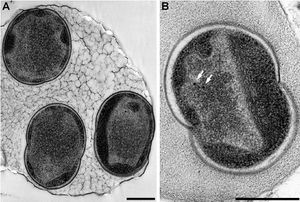Microthrix
From MicrobeWiki, the student-edited microbiology resource
Classification
Domain: Bacteria Phylum: Actinobacteria Class: Actinobacteria Order: Actinomycetales Family: Genus: Microthrix Species:
Description
Microthrix bacteria are one of the many bacterial genera found within activated sludge in wastewater treatment plants (WWTT's). In fact, certain species Microthrix parvicella have only be detected in the activated sludge of WWTPs. Some other species of Microthrix are found in marine environments and sediments. These bacteria are primarily responsible for some of the difficulty in separating the liquid and solid phases during activated sludge circulation. Their filamentous morphology causes bulk increases and material foaming that makes solid-liquid separation a bit difficult.
Microthrix are very long, thin cells with diameters not not exceeding .8 micrometers. They are easily identified under a light microscope because of their characteristic morphology and coiled appearance. They are gram-positive and are able to be grown in isolated culture.
They were first identified in the 1970's (Pasveer) but the first isolated cultures were not produced until almost twenty years after that. One set of conditions that they were isolated under was the following: Carbon source, glucose; Nitrogen source, ammonium sulfate; Sulphur source, sulfate; Added growth factor, vitamin B12 and thiamine; Isolation technique, dilution and plating; Maintenance, slant cultures at 4C.
It is studied primarily because of the issues it causes in WWTPs. The bulking and foaming that Microtrix cause is a real issue because if the solid and liquid materials cannot be separated effectively, then the desired activated sludge bacteria will not perform as well when recycled back into the reactor. Because of the issue that Microtrix presents, methods are under development to limit its growth in activated sludge. These methods, however, must be delicate and specific enough to target only Microtrix and to avoid removing or reducing other crucial bacterial species from the activated sludge. One method that is being used at some WWTPs is the reduction of the oxygen partial pressures in the reactors. Microtrix are facultative aerobes, so reducing the concentration of oxygen within the reactors reduces their metabolic rate and prevents them from proliferating and causing bulking and foaming issues.
Ecology and Significance
As covered earlier, Microthrix are found in and studied for the purpose of WWTP's. Other than creating bulking and foaming issues in the activated sludge of the WWTP's, the bacteria have a capacity to effect the sludge by manipulating available substrates based on their environmental conditions. For example, when isolated from anaerobic environments, the Microthrix were found to contain very large storage granules full of lipids. In experiments adding 14C oleic acid to anaerobic activated sludge, the added lipid was undetectable in the solution after twenty minutes. After performing MAR-FISH on the sample, it was clear that the culprit for the massive lipid uptake was the Microthrix bacteria. This rapid and significant uptake of free lipids in activated sludge has implications on the performance of the activated sludge as a whole. Many important bacterial species in activated sludge use fats as primary electrons donors or carbon sources. Thus, the excessive and rapid uptake of fats by Microthrix would limit these species' ability to grow and successfully fill their role in the activated sludge process.
Genome Structure
While no complete genome for Microthrix has been assembled as of yet, a draft genome was created by researchers in 2012. Here are some of the key statistics of the Microthrix draft genome.
Size: 4,202,850bp GC content: 66.4% Scaffolds/Contig of assembly: 13/16
The genome assembled contained many sequences that confirmed the observed functions of the Microthrix bacteria. For example, there is an identified, intact pentose phosphate pathway as well as a TCA cycle. Also, confirming its ability to store large amounts of lipids, the Microthrix bacteria genome contains almost thirty homologs of long-chain fatty acid acetyl-CoA ligase.
Metabolism
References
[1] Golyshin, Peter N. “Genome Sequence Completed of Alcanivorax borkumensis, a Hydrocarbon-degrading Bacterium That Plays a Global Role in Oil Removal from Marine Systems.” 3 (2003): 215-20. Print.
Figures
[1F]
[1] [2F] [2] [3F] [3] [4F] [4] [5F] [Original Figure. Author: Pawan Dhaliwal] [6F]
http://microbewiki.kenyon.edu/index.php/File:Lorenzo.gif
[7F] [5]
Author
Page authored by _____, student of Prof. Katherine Mcmahon at University of Wisconsin - Madison.

